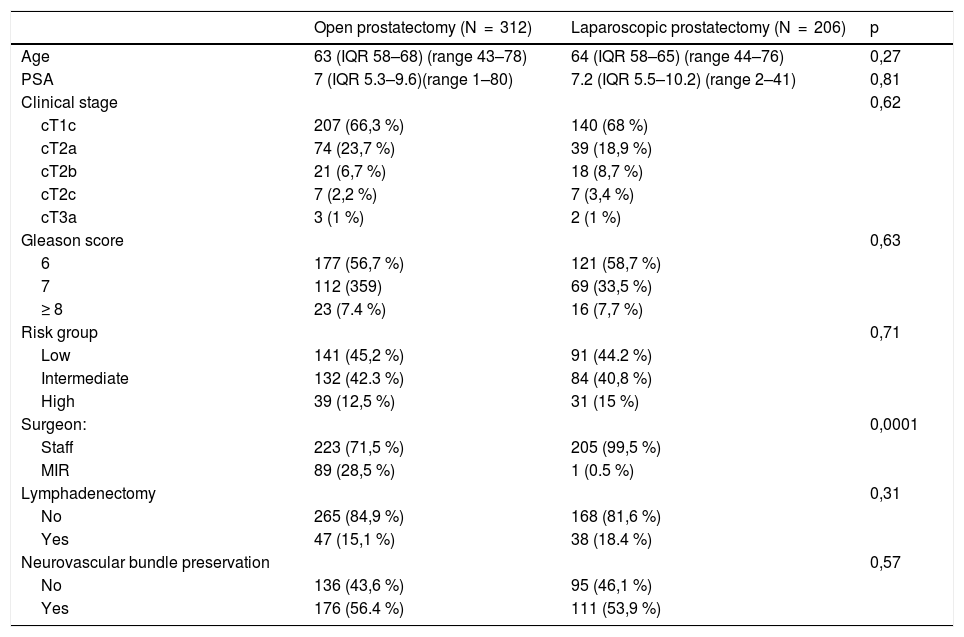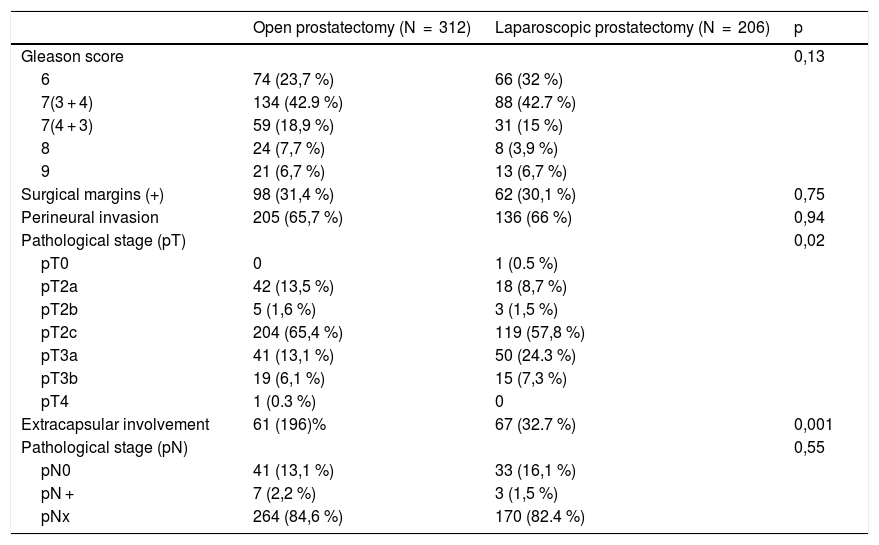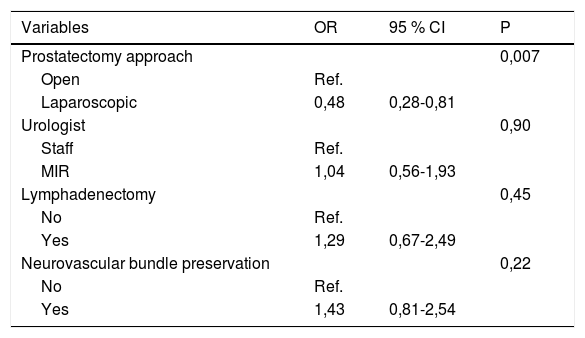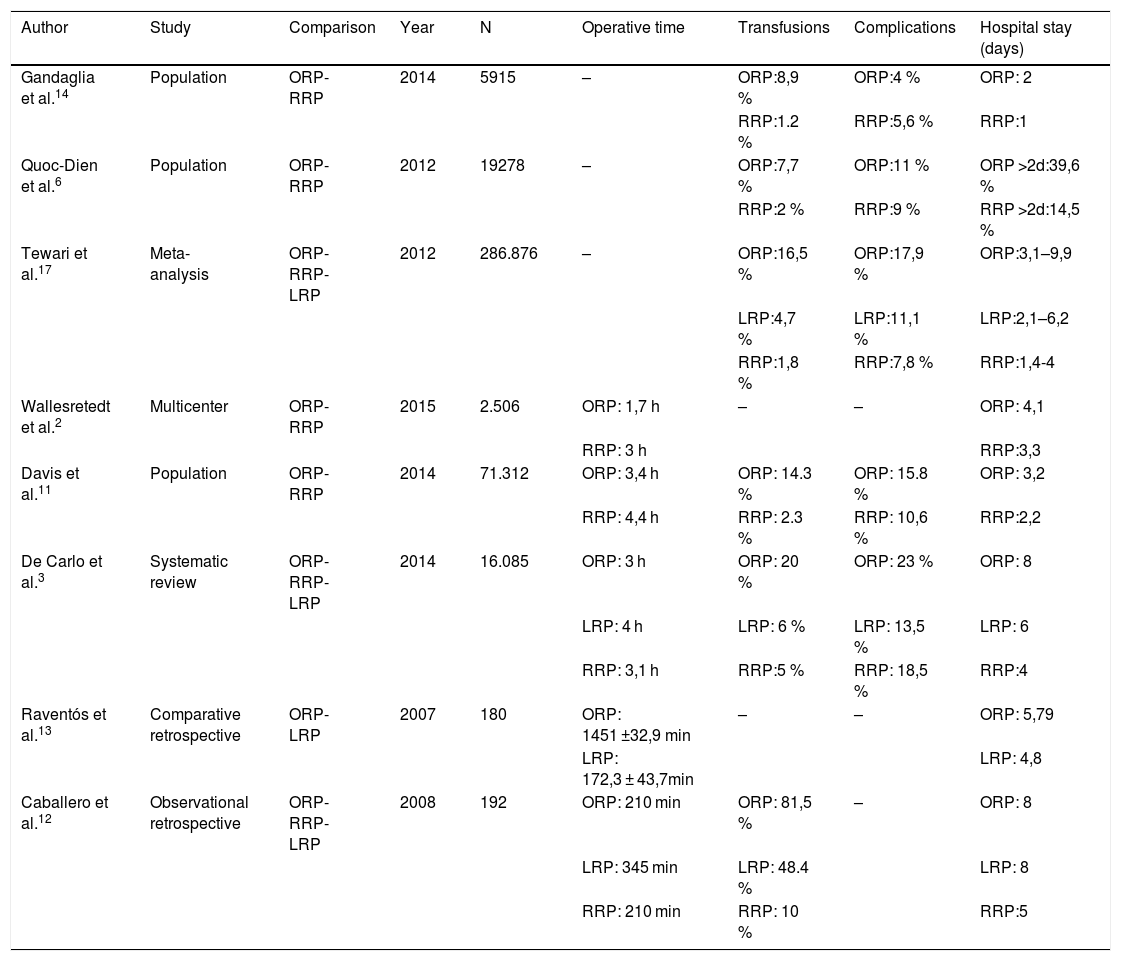There are very few articles comparing open radical prostatectomy (OPR) with laparoscopic radical prostatectomy (LRP).
ObjetivesTo compare the surgical time, the postoperative complications and the hospital stay in patients with localized prostate cancer treated with ORP or LRP.
Materials and methodsComparison between two patients cohorts (312 with ORP and with 206 LRP) between 2007-2015. Postoperative complications were collected as defined in to the EAU Guidelines recommendations and they were classified according to the Clavien-Dindo classification.
To compare the qualitative variables, we employed the chi-squared test and ANOVA for quantitative variables. We performed a multivariate analysis using logistic regression with dependent qualitative variables and a lineal regression with dependent continuous variables.
ResultsThe mean duration of ORP was 3:05 h and 4:35 h for LRP (p = 0,0001). The 26.4 % of the patients presented any postoperative complication. 31.2 % of ORP and 19.3 % of LRP (p = 0,003). The mean of hospital stay was 4 days. In ORP group was 4 days in contrast to LRP with 3 days (p = 0,008).
The LRP (p = 0,0001), lymphadenectomy (p = 0,02) and nerve-sparing (p = 0,01) were independent predictor factors of extension of surgical time. LRP was a protector independent factor of complications (OR = 0,48 p = 0,007). The type of prostatectomy didn’t influence in the length of hospital stay.
ConclusionsLRP showed higher surgical time, less complications and it didn’t influence the hospital stay.
Existen muy pocos estudios que comparen la prostatectomía radical abierta (PRA) con la prostatectomía radical laparoscópica (PRL).
ObjetivosComparar el tiempo quirúrgico, las complicaciones postoperatorias y la estancia hospitalaria en los pacientes con cáncer de próstata clínicamente localizado tratados mediante PRA y PRL.
Material y métodoComparación de dos cohortes (312 con PRA y 206 con PRL) entre 2007 y 2015. Las complicaciones postoperatorias se recogieron siguiendo las recomendaciones de las guías clínicas de la EAU y se agruparon según la clasificación de Clavien-Dindo.
Para el contraste de variables cualitativas se utilizó el test Chi-cuadrado y ANOVA para las cuantitativas. Análisis multivariable mediante regresión logística para variables dependientes cualitativas y mediante regresión lineal para las variables dependientes continuas.
ResultadosLa mediana de duración fue de 3:05 horas para la PRA y de 4:35 para la PRL (p = 0,0001). El 26.4% de pacientes presentaron alguna complicación en el postoperatorio. El 31.2% de PRA y el 19.3% de PRL (p = 0,003). La mediana de estancia fue de 4 días. En el grupo de PRA fue de 4 días, mientras que en el de PRL fue de 3 (p = 0,008).
La PRL (p = 0,0001), la realización de linfadenectomía (p = 0,02) y la conservación neuro-vascular (p = 0,01) fueron factores predictores independientes de prolongación del tiempo quirúrgico. La PRL fue un factor protector independiente de complicaciones (OR = 0,48 p = 0,007). El tipo de prostatectomía no influyó en la estancia hospitalaria.
ConclusionesLa prostatectomía laparoscópica consumió mayor tiempo quirúrgico, presentó menor porcentaje de complicaciones y no influyó en la estancia hospitalaria.











